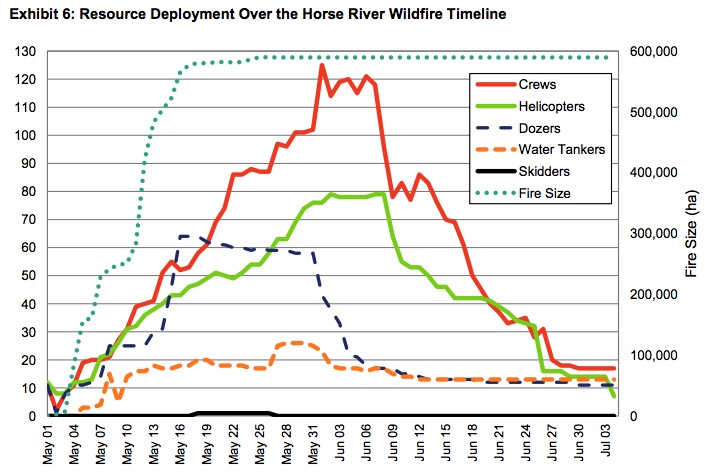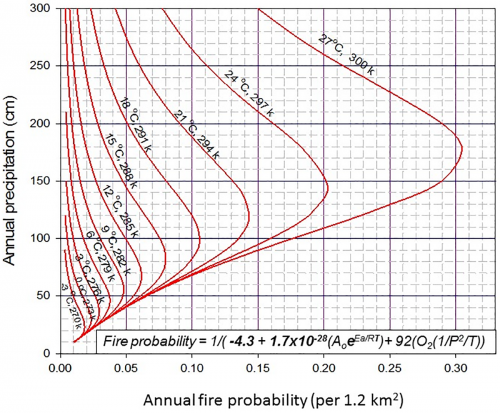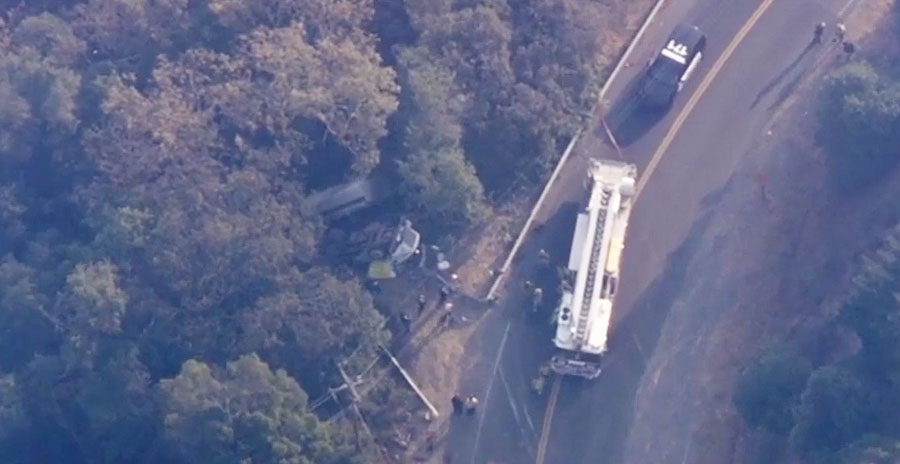Above: These two fires started at about the same time on May 1, 2016 near Fort McMurray, Alberta, Canada. Seen just after they started, on the left is the MMD-004 fire inside the city limits of Fort McMurray. The Horse River Fire, often referred to as the Fort McMurray Fire, is on the right. Alberta Forestry photo.
(Originally published at 4:04 p.m MST November 2,1 2017)
As the wildfire season slows in the western United States and Canada we have had a chance to look back on some of the more significant blazes. One of the largest in recent years, if not THE largest, was in 2016 in Alberta, Canada, the 589,552-hectare (1.4 million-acre) Horse River Fire that generally became known as the Fort McMurray Fire. It burst into the headlines when it burned into Fort McMurray destroying 2,400 structures and forcing 80,000 residents to evacuate for about a month.
No one was killed directly by the fire, but two young people died during the evacuation when their SUV collided head-on with a logging truck. One of them was a firefighter’s daughter, 15-year old Emily Ryan, one of three triplets. The other was Aaron Hodgson, her stepmother’s nephew.
Firefighters talk about “extreme fire behavior”, but this fire took it to a different level. For example, according to the report released in June, on May 4 high spread rates and downwind spotting drove the fire 40-45 kilometres (26-28 miles) to the southeast by the next morning. Convection column heights on the afternoon of May 4 reached 12.5 kilometres (41,000 feet or 7.8 miles) and lightning from the pyrocumulonimbus cloud atop the column started a number of new wildfires 40 kilometres (26 miles) ahead of the main wildfire front.
Yes, lightning from the smoke column and clouds created by it started multiple new fires 26 miles downwind.
As climate change extends the length of wildfire seasons, Alberta is no exception. Since 1994 50 percent of the wildfire acres (or hectares) burned in the province have occurred in May. And right on schedule, two fires started at about the same time on May 1, 2016, one within the city limits of Fort McMurray and another west of the city.
They were both detected by a “loaded patrol”, which is a helicopter with firefighters whose mission was to find new fires soon after they started and attack them quickly. The first air tanker group, two air tankers with a bird dog (lead plane), was on scene within 30 minutes. It would have been quicker but the nearest air tanker base, at Fort McMurray, was not staffed with tankers that day.
Below is an excerpt from the report where it discusses decisions made in the first few hours after the fire was detected by the firefighters patrolling in the helicopter.
“Complicating the situation was another wildfire that was reported almost simultaneously with the Horse River wildfire. This wildfire (known as wildfire MMD-004) was located immediately inside the boundary of Fort McMurray, and was in similar forest and weather conditions as the Horse River wildfire. Both wildfires received ground wildland firefighting crews. When air tankers arrived, AF [Alberta Forestry] officials were forced to choose between the Horse River wildfire and MMD-004 for initial air attack. [The photo above shows] both the Horse River wildfire and wildfire MMD-004 on May 1, at 18:35h.
“At the time, wildfire MMD-004 was in closer proximity to structures in the community than the Horse River wildfire and thus posed the greater immediate risk. It was also evident to the first air attack officer that applying air attack on wildfire MMD-004 was more likely to yield a successful result (a decision balancing risk and probability of success). With the exhibited fire behaviour and the time that had passed for the wildfire to gain some momentum, the Horse River wildfire was likely to outpace the actions of the dispatched air tanker groups. Crews on the ground could begin to fight the Horse River wildfire near the origin, but neither ground or air attack would be successful directly on the head of the wildfire. In the end, this judgement proved correct, and wildfire MMD-004 was successfully suppressed without damage to the surrounding values. The consequence was a further delay in the use of air attack to slow or redirect the Horse River wildfire.
“Within the first hour of commencing suppression activities on the Horse River wildfire, it became clear that initial attack efforts would not be successful in containing the wildfire. This awareness required another transition in the thinking of AF and RMWB [Regional Municipality of Wood Buffalo]. Operational personnel would continue to attack the wildfire, but the plan needed to shift to the requirement for expanded operations.”






